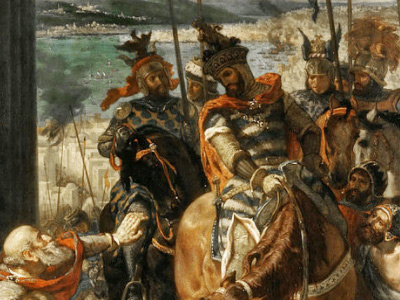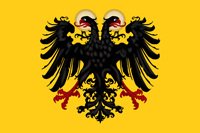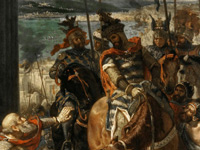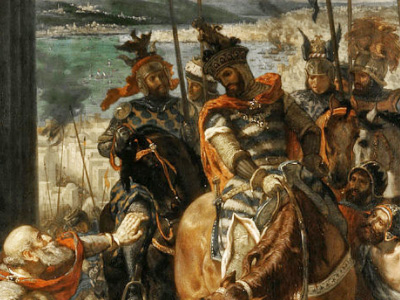Fourth Crusade (1202–04)

The Crusade Begins
Pope Innocent III succeeded to the papacy in January 1198, and the preaching of a new crusade became the prime goal of his pontificate, expounded in his bull Post miserabile. His call was largely ignored by the European monarchs: the Germans were struggling against Papal power, and England The Kingdom of England was a sovereign state on the island of Great Britain from about 927, when it emerged from various Anglo-Saxon kingdoms, until 1 May 1707, when it united with Scotland to form the Kingdom of Great Britain. The Viking invasions of the 9th century upset the balance of power between the English kingdoms, and native Anglo-Saxon life in general. The English lands were unified in the 10th century in a reconquest completed by King Æthelstan in 927. and France
The Kingdom of England was a sovereign state on the island of Great Britain from about 927, when it emerged from various Anglo-Saxon kingdoms, until 1 May 1707, when it united with Scotland to form the Kingdom of Great Britain. The Viking invasions of the 9th century upset the balance of power between the English kingdoms, and native Anglo-Saxon life in general. The English lands were unified in the 10th century in a reconquest completed by King Æthelstan in 927. and France The Kingdom of France is the historiographical name or umbrella term given to various political entities of France in the medieval and early modern period. It was one of the most powerful states in Europe since the High Middle Ages. It was also an early colonial power, with possessions around the world. Colonial conflicts with Great Britain led to the loss of much of its North American holdings by 1763. The Kingdom of France adopted a written constitution in 1791, but the Kingdom was abolished a year later and replaced with the First French Republic. were still engaged in warfare against each other. However, due to the preaching of Fulk of Neuilly, a crusading army was finally organized at a tournament held at Écry-sur-Aisne by Count Thibaut of Champagne in 1199. Thibaut was elected leader, but he died in 1201 and was replaced by an Italian count, Boniface of Montferrat.
The Kingdom of France is the historiographical name or umbrella term given to various political entities of France in the medieval and early modern period. It was one of the most powerful states in Europe since the High Middle Ages. It was also an early colonial power, with possessions around the world. Colonial conflicts with Great Britain led to the loss of much of its North American holdings by 1763. The Kingdom of France adopted a written constitution in 1791, but the Kingdom was abolished a year later and replaced with the First French Republic. were still engaged in warfare against each other. However, due to the preaching of Fulk of Neuilly, a crusading army was finally organized at a tournament held at Écry-sur-Aisne by Count Thibaut of Champagne in 1199. Thibaut was elected leader, but he died in 1201 and was replaced by an Italian count, Boniface of Montferrat.
Boniface and the other leaders sent envoys to Venice, Genoa, and other city-states in 1200 to negotiate a contract for transport to Egypt, the object of their crusade; one of the envoys was the future historian Geoffrey of Villehardouin. Earlier crusades focused on Palestine had involved the slow movement of large and disorganized land hosts across a generally hostile Anatolia. Egypt was now the dominant Muslim power in the eastern Mediterranean but also a major trading partner of Venice. An attack on Egypt would clearly be a maritime enterprise, requiring the creation of a fleet. Genoa was uninterested, but in March 1201 negotiations were opened with Venice, which agreed to transport 33,500 crusaders, a very ambitious number. This agreement required a full year of preparation on the part of the Venetians to build numerous ships and train the sailors who would man them, all the while curtailing the city's commercial activities. The crusading army was expected to consist of 4,500 knights (as well as 4,500 horses), 9,000 squires, and 20,000 foot-soldiers.
The majority of the crusading army that set out from Venice in early October 1202 originated from areas within France. It included men from Blois, Champagne, Amiens, Saint-Pol, the Île-de-France, and Burgundy. Several other regions of Europe sent substantial contingents as well, such as Flanders and Montferrat. Other notable groups came from the Holy Roman Empire The Holy Roman Empire was a political entity in Western, Central, and Southern Europe that developed during the Early Middle Ages and continued until its dissolution in 1806 during the Napoleonic Wars. From the accession of Otto I in 962 until the twelfth century, the Empire was the most powerful monarchy in Europe. The empire reached the apex of territorial expansion and power in the mid-thirteenth century, but overextending led to partial collapse., including the men under Bishop Martin of the Pairis Abbey and Bishop Conrad of Halberstadt, together in alliance with the Venetian soldiers and sailors led by the doge, Enrico Dandolo. The crusade was to be ready to sail on 24 June 1203 and make directly for the Ayyubid capital, Cairo. This agreement was ratified by Pope Innocent, with a solemn ban on attacks on Christian states.
The Holy Roman Empire was a political entity in Western, Central, and Southern Europe that developed during the Early Middle Ages and continued until its dissolution in 1806 during the Napoleonic Wars. From the accession of Otto I in 962 until the twelfth century, the Empire was the most powerful monarchy in Europe. The empire reached the apex of territorial expansion and power in the mid-thirteenth century, but overextending led to partial collapse., including the men under Bishop Martin of the Pairis Abbey and Bishop Conrad of Halberstadt, together in alliance with the Venetian soldiers and sailors led by the doge, Enrico Dandolo. The crusade was to be ready to sail on 24 June 1203 and make directly for the Ayyubid capital, Cairo. This agreement was ratified by Pope Innocent, with a solemn ban on attacks on Christian states.
HISTORY

RESOURCES
This article uses material from the Wikipedia article "Fourth Crusade (1202–04)", which is released under the Creative Commons Attribution-Share-Alike License 3.0.
© Stories Preschool. All Rights Reserved.






